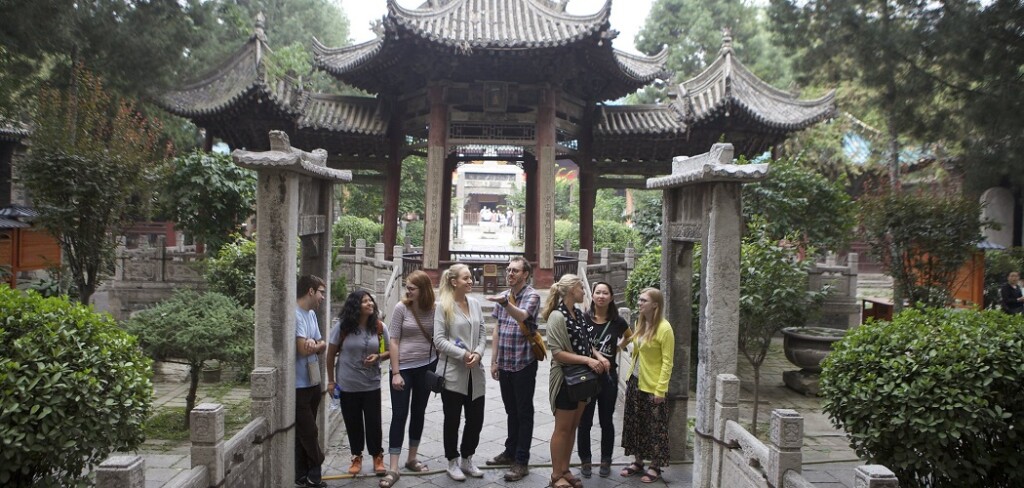Page 120 • (1,269 results in 0.087 seconds)
-
the field of Holocaust Studies in the US and abroad. Before joining the Museum, Mr. Shapiro served in the Bureau of Educational and Cultural Affairs at the United States Information Agency and Department of State, where he was responsible for the Fulbright Fellowship Program and other major international exchange programs. Earlier, he was an Editor of the journal Problems of Communism and Editor in Chief of the Journal of International Affairs. Mr. Shapiro served as a consultant to the Justice
-

year! Did you know? From Chinese music recitals and lectures to small group discussions with visiting Chinese scholars and Chinese-style dinner parties, there are plenty of opportunities to continue your learning outside the classroom! Did you know? PLU’s Kreidler Global Residence Hall gives Chinese Studies students the option to live in the Chinese language wing, and focus on global awareness, language immersion, and cultural engagement. Students practice their language with other community
-

are different from your own. I’m from a very rural place (my graduating class was 39 students), so coming to PLU in general and then going to downtown Tacoma for J-term on the Hill, which is even more urban, was a little bit of cultural shock for me. It was very similar to other study away experiences in that I went to a different community to able to learn from them and how to work with them. Every study away experience has had some kind of aspect of service to it, which I’ve really loved because
-
taught as “Literature of the Raj” ENGL 217 when taught as “Asian-American Literature”; “Civil Disobedience: American Protest Literature of Race and Justice” ENGL 380 when taught as “Global Refugee Literature” IHON 112: Liberty, Power, and Imagination NAIS 363: Race and Indigeneity POLS 288 when taught as “Latino Experience in America” POLS 365: Racial and Ethnic Politics POLS 370: Prisons & Prisoners PSYC 335: Cultural Psychology PSYC 387 when taught as “Race, Anti-Racism, and Child Development” RELI
-
of instructor. Cross-listed with RELI 391. (4) SOCI 410 : Social Stratification An examination of the cultural and structural causes of social stratification and its consequence, social inequality. The course focuses on stratification and inequality on the basis of race, class, and gender, exploring what social forces shape individuals' differentiated access to society's valued resources. Prerequisite: SOCI 101 or consent of instructor. (4) SOCI 413 : Criminological Theories An analysis of
-
Ave. The sculpture, a reminder of the university’s Nordic roots, is 25 feet tall and weighs 2,200 pounds. In the spring of 1992, the Viking ship prow made its way from Anacortes, Washington, to its present location in front of the Scandinavian Cultural Center in the University Center. The planking is Western Red Cedar, and the fasteners are copper rivets and roves from Norway. The artist, Paul Schweiss, is a boat builder with Nordic connections. × Anderson Clock Tower Date: 1970 See it: The
-
of feminist narratological thinkers who are interested in investigating how female literary texts are informed by the societal and cultural confines placed on women writers. This essay specifically analyzes how Jane Austen’s Mrs. Bennet was written, and in investigating her discourse as well as the narrator’s depictions, I will uncover her subverted feminist role in Pride and Prejudice. On the surface, Mrs. Bennet appears to be a character who completely represents nineteenth-century societal
-
Narratives in MuseumsGiven their ability to control, solidify, and create narratives of cultural identity, museums have increasingly become contested spaces. Museum studies and curatorial practices have recently begun to (re)contextualize their place and meaning in postcolonial and decolonial contexts. Their contents and exhibits, often disputed examples of material culture themselves, anchor these narratives, but the physical context of the museum building itself is a central yet under-studied component
-
., prisons or mental hospitals), mental or physical capacities, or the political/cultural in which they live and work. Researchers must make a special effort to ensure that potential participants are given every opportunity to exercise free choice in consenting to participate in a research project. Special Populations Certain types of participants require special attention when obtaining informed consent. In all cases, the guiding principle is respect for the rights of the potential participant. Federal
-
and freshly painted natural curls at the same time. In this way, the portrait becomes a symbol representing both sides of Georgiana’s familial and cultural African and European backgrounds. This is a deeply personal context in the midst of an intimate scene, and it is at the same time a political statement. A little over a week after the April 17th episode aired, The New York Times published the article “In Films and on TV, a New Openness to Natural Black Hairstyles”, which while it does not cite
Do you have any feedback for us? If so, feel free to use our Feedback Form.


